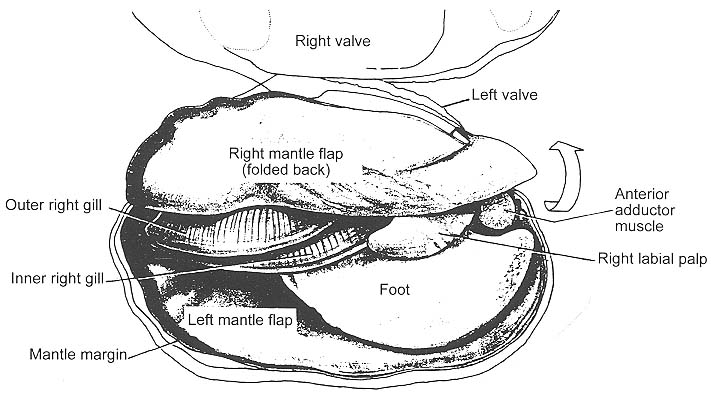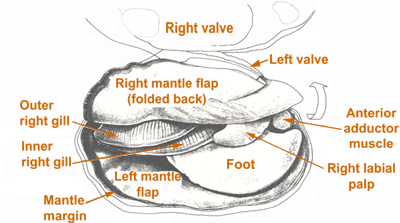Mussel
Anatomy Lesson Plan

Objective:
Students will identify the names and functions of the parts of a mussel,
including the shell, mantle, gills, digestive system, circulatory system,
nervous system, adductor muscles, siphons, umbo, and foot by examining
a mussel and a model or labeled anatomical chart of a mussel. They will
explain how the physical adaptations help the mussel survive in its
environment.
Grades:
4 - 8
Time Required: one class period (may be used together with mussel
life cycle lesson and mussel habitat diorama lesson)
Materials:
One or more freshwater mussels Mussel anatomy chart (see below and in
pdf version for printout format) https://dnr.state.il.us/lands/education/mussels/anatomy.htm
online version at DNR (Mussel model)
ISM and Other
Online Resources: https://www.museum.state.il.us/RiverWeb/harvesting/harvest/mussels/index.html
Harvesting the River Online exhibit musselling section
https://www.museum.state.il.us/ismdepts/zoology/collections/mussel
ISM's online collection of mussel images
https://www.uvm.edu/~pass/tignor/mussels/index.htm
University of Vermont Web module for elementary students on mussels.
https://dnr.state.il.us/lands/education/mussels/intro.htm
Department of Natural Resources' education pages for mussels. https://www.inhs.uiuc.edu/cbd/musselmanual/cover.html
Freshwater Mussels of the Midwest book to order. https://www.inhs.uiuc.edu/cbd/musselmanual/TofC.html
online sections of the book above include anatomy, species accounts
with photographs.
Motivation:
A freshwater mussel is a soft-bodied animal with a muscular head and
foot and a mantle, which usually secretes a protective shell. (Online
glossary is at https://www.inhs.uiuc.edu/cbd/musselmanual/glossary.html.)
This animal is important to balanced river ecology. The presence or
absence, increase or decrease, in population of mussels in a river can
be a telling story about the health of that river.
Procedure:
- Look at the Museum's Web presentation Harvesting the River to
introduce the students to the role of the mussel in the ecologic and
economic life of Illinois as part of a unit on rivers or ecology.
- Notice the many kinds of mussels in Illinois waters by looking at the
photo gallery of mussel shells.
- Prepare and dissect a mussel according to the lesson description presented
by the https://www.irh.k12.nf.ca/mussels/morpholo.htm.
Web site. Note that this dissection is of a saltwater mussel, not
a freshwater mussel.
- Use the DNR mussel anatomy chart to point out which parts of the freshwater
mussel the students are looking at (as the size and tissues of the mussel
are sometimes difficult to see clearly).
Assessment:
Given a list of the parts of a mussel, or a simple diagram (see page
4) of the parts of a mussel, the students will be able to identify,
label and define these parts in writing, and explain how the physical
adaptations help the mussel survive in its environment.
Illinois State
Board of Education Goals Addressed:
Science: Elementary
12.B.2a: Describe relationships among various organisms in their
environments (e.g., predator/prey, parasite/host, food chains and food
webs).
12.B.2b: Identify physical features of plants and animals that
help them live in different environments (e.g., specialized teeth for
eating certain foods, thorns for protection, insulation for cold temperature).
12.B.3a: Identify and classify biotic and abiotic factors in
an environment that affect population density, habitat and placement
of organisms in an energy pyramid.
12.B.3b: Compare and assess features of organisms for their adaptive,
competitive and survival potential (e.g., appendages, reproductive rates,
camouflage, defensive structures). Label the parts of the mussel. Below
the diagram, write the function of each part.


